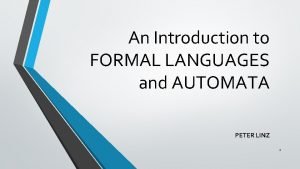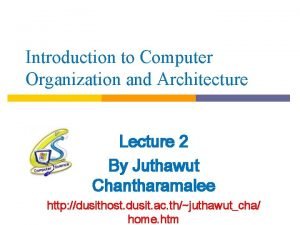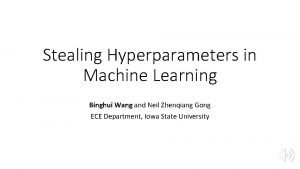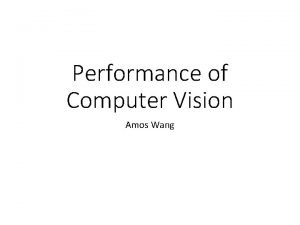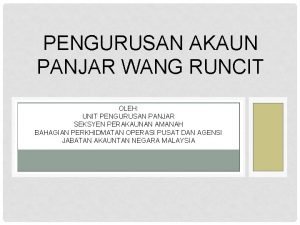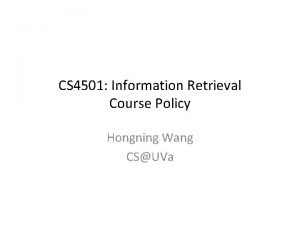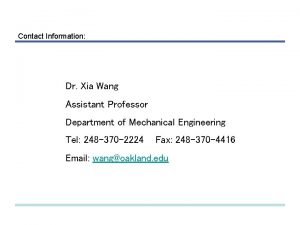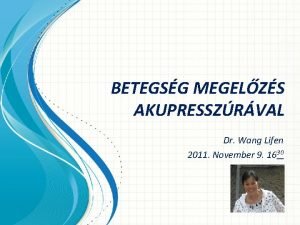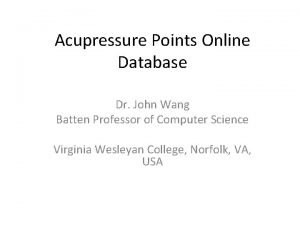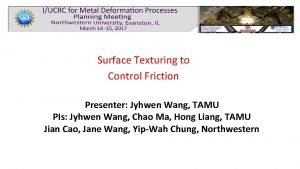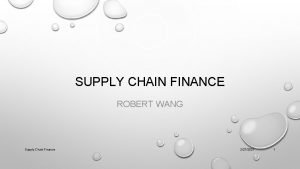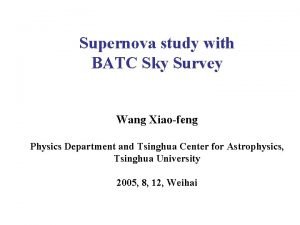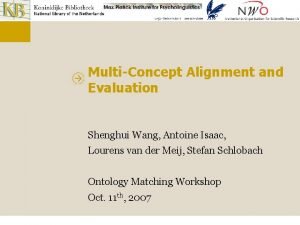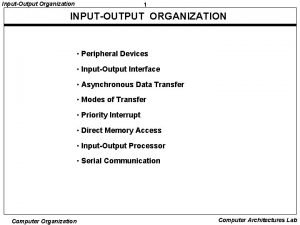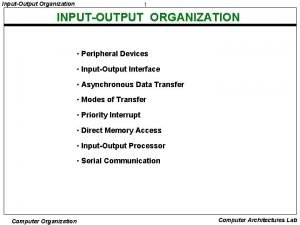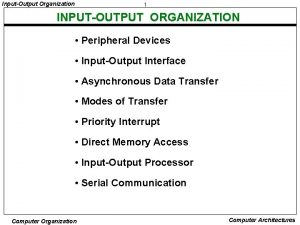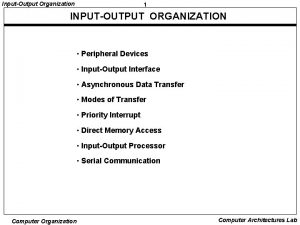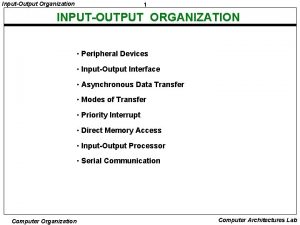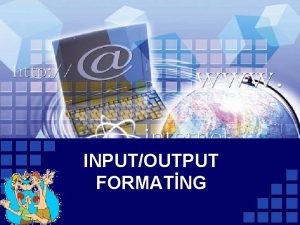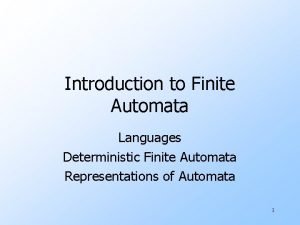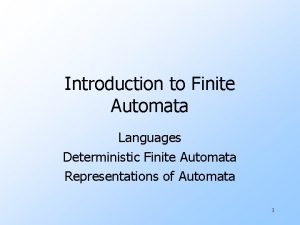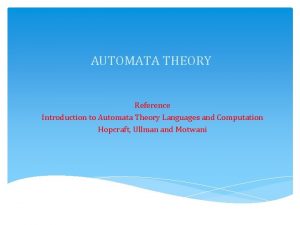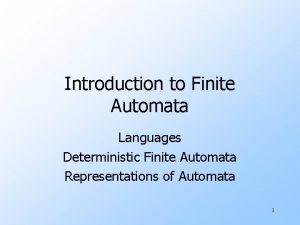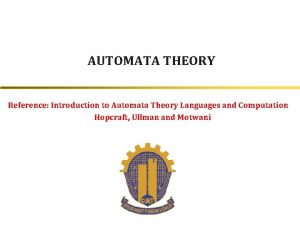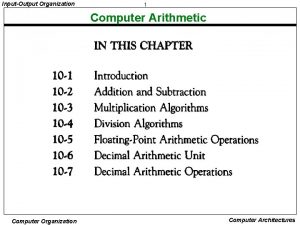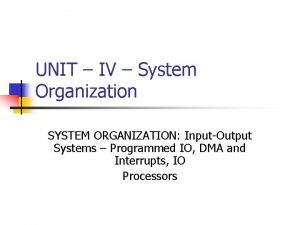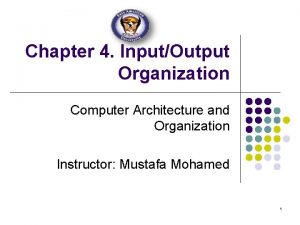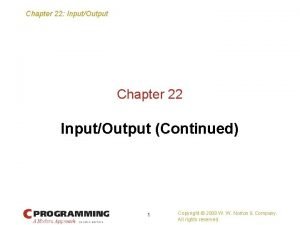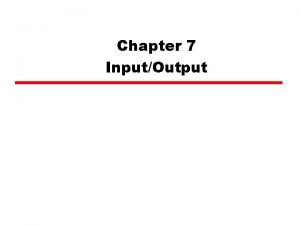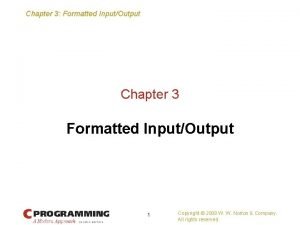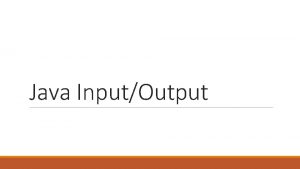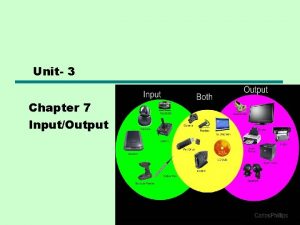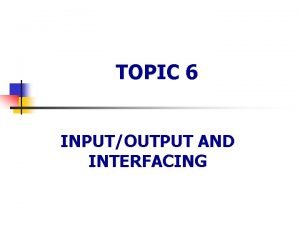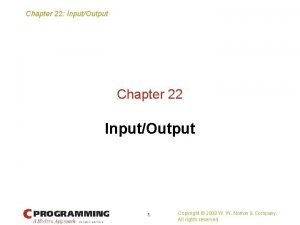An Introduction to InputOutput Automata Qihua Wang Organization




































- Slides: 36

An Introduction to Input/Output Automata Qihua Wang

Organization • • • Overview of the I/O automaton model Composition of I/O automata Fairness Specification Introduction to proof techniques

Overview of the Model • Model for discrete event systems consisting of concurrently-operating components – Instead of simply computing some function of their input and halting, they receive input from and react to their environment. – Each system component is modeled as an I/O automaton

Overview of the Model • Distinction between those actions whose performance is under the control of the automaton and those actions whose performance is under the control of its environment. • An automaton's actions are classified as either `input', `output', or `internal‘. Output Automaton Environment Input

Overview of the Model • An automaton can establish restrictions on when it will perform an output or internal action, but it is unable to block the performance of an input action. • “If the environment behaves correctly, then the automaton behaves correctly. ”

Overview of the Model • I/O automata may be nondeterministic • I/O automata can be composed to yield other I/O automata • Fair execution • A problem to be solved by an I/O automaton is formalized as an arbitrary set of (finite and infinite) sequences of external actions. • Solve a problem • Abstraction mapping

Some Uses • Describe concurrent algorithms • Algorithm correctness proofs • Complexity analysis

The Input/Output Automaton Model • Interface between the automaton and environment: action signature – in(S), out(S), int(S) • External actions – ext(S) = in(S) ∪ out(S) • Locally-controlled actions: – local(S) = out(S) ∪ int(S)

The Input/Output Automaton Model • Five components: – – An action signature sig(A), A set states(A) of states, A nonempty set start(A) in states(A) as start states, A transition relation steps(A): states(A) × acts(A) × states(A) with the property that for every state s’ and input action π there is a transition (s’, π, s) in steps(A), – An equivalence relation part(A) partitioning the set local(A) into at most a countable number of equivalence classes.

The Input/Output Automaton Model • If (s’, π, s) a step of A, then π is said to be enabled in s’. • Two fundamental assumptions – Unable to block its input – The performance of an action is controlled by at most one system component

The Input/Output Automaton Model • An execution fragment is a finite sequence s 0, π1, s 1, π2, …… πn, sn or an infinite sequence of A such that (s’i, πi+1, si+1) is a step of A for every i. • An execution is an execution fragment beginning with a start state. Denoted the set of executions by execs(A), finexecs(A).

The Input/Output Automaton Model • The schedule of an execution fragment α is the subsequence of α consisting of the actions appearing in α. The set of schedules is denoted by sched(α), finsched(α). • The behavior of an execution or schedule α of A is the sequence of α consisting of external actions and is denoted by beh(α). • Event : A particular occurrence of an action

Candy Machine • The signature of CM-1 • State of CM-1 : variable ‘button-pushed’ • Initial state : button_pushed = 0

Candy Machine • Transition relation for CM-1

Candy Machine • CM-2 : HEATHBAR action has ‘false ’ as its precondition. • CM-3 : All the three candy dispensation actions have ‘false’ as their precondition.

Candy Machine • Customer CUST-1 continues to request candy bars, nondeterministically choose which button to push. The state of CUST-1 consists of one variable ‘waiting’, which takes on values ‘yes’ and ‘no’. • CUST-2 pushes button 2 repeatedly until the machine dispenses a HEATHBAR, and then pushes button 1 forever. Besides ‘waiting’, CUST -2 has another state variable ‘heathbar_received’.

Candy Machine • CUST-3 is similar to CUST-1 except that it may make a transition to a ‘satiated’ state from which it no longer requests any candy bars.

Composition • Construct an automaton modeling a complex system by composing automata modeling the simpler system components. • When compose a collection of automata, identify an output action π of one automaton with the input action π of each automaton having π as an input action • When one automaton having π as an output action performs π, all automata having π as an action perform π simultaneously (automata not having π as an action do nothing).

Composition • E. g. in the composition of CM-1 and CUST-1, the output action PUSH 1 of the customer with the input action PUSH 1 of the candy machine. • The occurrence of PUSH 1 causes both the candy machine and the customer to perform PUSH 1, causing button pushed to be set to 1 in the candy machine's local state, and waiting to be set to `yes' in the customer's local state. • This synchronization models a form of communication from the customer to the candy machine.

Composition • A countable collection {Si} of action signatures is said to be strongly compatible if for all i ≠ j, we have 1. 2. 3. • out(Si) ∩ out(Sj) = Φ, int(Si) ∩ acts(Sj) = Φ, and No action is contained in infinitely many sets acts(Si). A collection of automata are strongly compatible if their action signatures are strongly compatible

Composition • The composition signature S of a countable collection of strongly compatible action signatures {Si} is defined to be: • Internal actions of the components become internal actions of the composition, output actions become output actions, and all other actions become input actions.

Composition • Automaton composition – part(A) = ∪part(Ai)

Composition • An execution of a composition induces executions of the component automata. • Given an execution α = s 0 π1 s 1 π2 …… of A, let α|Ai be the sequence obtained by deleting πk sk when πk is not an action of Ai and replacing the remaining sk by sk[i].

Fairness • The property that infinitely often the component is given the opportunity to perform one of its locally controlled actions – E. g. CUST-4 does not wait for a candy bar before pressing a button again. One behavior of the composition CM-1∙CUST-4 is the infinite sequence 1111… – CM-1∙CUST-4 has equivalent classes {S, H, A} and {1, 2} – Being fair to each component means being fair to each equivalence class of locally controlled actions. – 11 S… is a fair behavior of CM-1∙CUST-4

Fairness • Fair execution: the following condition hold for each equivalence class C: 1. If α is finite, then no action of C is enabled in the final state of α. If α is infinite, then either α contains infinitely many events from C, or α contains infinitely many occurrences of states in which no action of C is enabled. 2.

Problem Specification • A problem specification is simply a set of allowable `behaviors’. • The automaton solves the problem in the sense that every `behavior’ it exhibits is a `behavior' allowed by the problem specification.

Problem Specification • Schedule module H: 1. 2. • • an action signature sig(H), and a set scheds(H) of schedules. Fair behaviors Composition of strongly compatible schedule modules

Problem Specification • A problem is simply a schedule module P. • An automaton A solves a problem P if A and P have the same external action signature and fairbehs(A) fairbehs(P). • An automaton A implements a problem P if A and P have the same external action signature (that is, the same external interface) and finbehs(A) finbehs(P).

Problem Specification • Safety properties are informally characterized by the fact that they specify a property that must hold in every state of a computation. • Liveness properties are informally characterized by the fact that they specify events that must eventually be performed.

Problem Specification • E. g. SAFE-CM has the same action signature as CM-1, and has as its set of schedules the set of sequences over the symbols 1, 2, S, H, A satisfying the following condition: Every S is immediately preceded by a 1, and every A or H is immediately preceded by a 2. • Prove that CM-1 is a safe candy machine

Problem Specification • Define ‘well-formedness’ conditions on the interaction between the machine and its environment

Problem Specification • E. g. Define a sequence of candy machine actions to be well -formed if it consists of alternating input and output (push and dispensation) actions, starting with an input action. • LIVE-CM : ‘If the sequence is well-formed, then every 1 event is followed by a later S event, and every 2 event is followed by a later H or A event. ’ • CM-3 is not a live candy machine. CM-1 and CM-2 are live candy machines.

Problem Specification • In general, given an automaton A and a problem P , it is not the case that if A solves P then A implements P , nor is it the case that if A implements P then A solves P.

Proof Techniques • Modular Decomposition – we reason about the behavior of a composition by reasoning about the behavior of the component automata individually. • Hierarchical Decomposition – given automaton solves a second, that the second solves a third, and so on until the final automaton solves the given problem. – use possibilities mapping from one automaton to another

Other Application • • Network Resource Allocation Synchronizers Communication Concurrency Control Shared Atomic Objects Dataflow Real-Time Computing

Thank you! End
 Inputoutput devices
Inputoutput devices An introduction to formal languages and automata
An introduction to formal languages and automata Process organization in computer organization
Process organization in computer organization Point by point organization example
Point by point organization example Introduction to computer organization and architecture
Introduction to computer organization and architecture Structural inertia resistance to change
Structural inertia resistance to change Introduction to computer organization
Introduction to computer organization Introduction to management and organization
Introduction to management and organization Introduction to business organization
Introduction to business organization Regina wang md
Regina wang md Stealing hyperparameters in machine learning
Stealing hyperparameters in machine learning Yongge wang
Yongge wang Caroline c wang
Caroline c wang Amos wang
Amos wang Contoh surat turun kuasa
Contoh surat turun kuasa Kegunaan panjar wang runcit
Kegunaan panjar wang runcit Huazheng wang
Huazheng wang Akta wang tak dituntut 1965
Akta wang tak dituntut 1965 Holtek semiconductor inc
Holtek semiconductor inc Hongning wang
Hongning wang Dr xia wang
Dr xia wang Dr kenneth wang
Dr kenneth wang Minmei wang
Minmei wang Meridián pontok jelentése
Meridián pontok jelentése Yi-chia wang
Yi-chia wang Dr john wang
Dr john wang Ryan wang hsbc
Ryan wang hsbc Guanhua wang
Guanhua wang Landy wang microsoft
Landy wang microsoft Jyhwen wang
Jyhwen wang Dr robert wang
Dr robert wang Wang
Wang Annie leibovitz album covers
Annie leibovitz album covers Tom wang masterclass
Tom wang masterclass Shenghui wang
Shenghui wang Jumlah denominasi wang kertas malaysia
Jumlah denominasi wang kertas malaysia Jeffrey wang microsoft
Jeffrey wang microsoft

